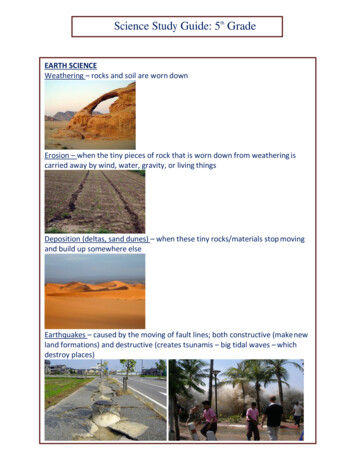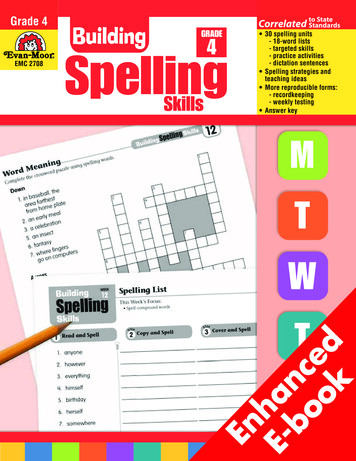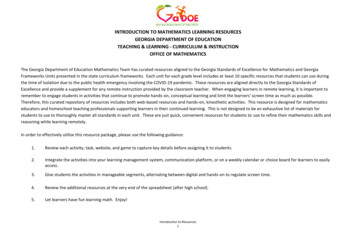
Transcription
Science Study Guide: 5th GradeEARTH SCIENCEWeathering – rocks and soil are worn downErosion – when the tiny pieces of rock that is worn down from weathering iscarried away by wind, water, gravity, or living thingsDeposition (deltas, sand dunes) – when these tiny rocks/materials stop movingand build up somewhere elseEarthquakes – caused by the moving of fault lines; both constructive (make newland formations) and destructive (creates tsunamis – big tidal waves – whichdestroy places)
Faults – San Andreas Fault is one of the most famous fault lines; there aredifferent types of faults depending on the how the tectonic plates collide; whenthe tectonic plates collide, they form many new land formations like mountainsVolcanoes - the lava makes new land formations (Hawaiian Islands); however,the lava destroys everything in its path firstIMPACT OF ORGANISMSDust Bowl – poor farming techniques helped cause the dust bowl; clouds of dustwould enter the towns affecting many things
IMPACT OF ORGANSIMS CONT People, animals, insects, and reptiles all disturb the upper layers of the Earth which makes it more easy forweathering and erosion to occur; humans are the biggest ‘disturbers’ ofthe Earth. the loss of this good topsoil lowers the quality of growing soil whichmakes it more expensive and harder to grow good cropsPreventing erosion – plant flowers and plants; put mulch or fertilizer down; putretaining walls/edging downSeismograph – used to measure the movement of the ground during anearthquake scientists can warn people of incoming tsunamis with this technologySeismic Waves – waves of energy caused by a sudden breaking of rock with theEarth or an energy that travels through the Earth and is recorded onseismographs
Richter Scale – scores earthquakes from 1-10 depending on the amount ofmovement that the earthquake causesFlood control – keeps water from overflowing onto land and towns dams – help control the flow of water from major rivers and is turnedinto electric energy levees – designed to control the flow of water; they do not block waterbut rather make the sides of the river taller to prevent flood damage tocities, houses, and businesses storm drain management – heavy rainfall leads to large amounts of waterrunning through cities and towns; the drain management system helpswith that water flowBeach reclamation (Georgia coastal islands) – the act of reclaiming a beach fromerosion by adding sand and ‘reclaiming’ the shoreline as it once was
PHYSICAL SCIENCEAn object is the sum of its parts – no matter how parts of an object are puttogether, the weight of the whole object is ALWAYS the samematter – anything that occupies spacemass – how much matter is in that spaceweight – how mass of an object is affected by gravityvolume – how much space an object takes up density– how solid an object isphysical properties – things that can be measured or observedmagnification – scientist use technology to see things our eyes cannot seePhysical Change – changes affecting the form of a chemical substance, but doesnot change its chemical composition
States of Mattersolid – when the particles are packed closely togetherliquid – fluid that conforms to the shape of its containergas – compressible fluid that can conforms to the shape of its container but canmake it bigger as wellCHANGES IN MATTERPhysical change – changes the form but not composition (molecules) temperature – water changes to ice when the temperature is lowered to32 degree Fahrenheit. Water boils and turns into vapor when it is heat to12 degree Fahrenheit.Chemical change -occurs when a substance combines with another newsubstance combustion – burning candle or wood dissolve – mixing salt in water digestion – food breaking down in your stomach acid
Electricity – components for an electrical current: power source, wire, and abulbconductors – objects that all electricity to flow through them examples: most metals like copper, iron, steel, silver, gold; but also waterinsulators – materials that do not all electricity to flow through them examples: rubber and plasticstatic electricity – occurs when opposite charges attract (lightening is a form;rub a balloon on your sweater and then put it to a kid’s hair Bar magnet VS an Electromagnet bar magnets maintains a constant magnetic pull electromagnets can be turned on or off (good for simple motors)o opposite magnetic poles attract and similar magnetic poles repeleach other
LIFE SCIENCEinherited traits – these are physical traits (DNA) you get from your parents eye color, hairline, ear size, skin color, freckles, allergieslearned behaviors – what a person learns through observation from parents orguardians, friends, teachers, TV, etc. manners, how you treat people, riding a bike, learning, reading, writinggenes – DNA passed from parent to child even though biological parents have control over the physical aspects of aperson’s being, guardians and step-parents play a major role in a person’straits as well (I should know, I was raised by my step-dad and we are ALOT alike Classifying Organismsvertebrates – an animal with a backboneinvertebrates – an animal without a backbone
Vertebrate Groups – fish, amphibian, reptile, bird, mammalPLANT GROUPINGplants with seeds gymnosperms - seeds in cones angiosperms - seeds in fruito plants that reproduce with flowersplants without seeds vascular – tissue that makes them tall (trees) non-vascular- do not have the special tissue so they are short (moss)(vascular)(non-vascular)
CELLS – EVERY living thing is made up of cells. (the human body has around 75trillion cells!)Purpose of cells keeps people health transporting oxygen cells help us movePlant Cellular Make-up membrane – thin layer just outside the cell wall that is soft which allowssome things in to make the plant stronger; keeps all the pieces inside wall cytoplasm – thicker part of the plant for protection nucleus – central part of an atom chloroplasts – food for plantsAnimal Cellular Make-up membrane – cholesterol for people; keeps all the things inside cytoplasm – helps move materials around the cell and dissolves in cellularwaste nucleus – central part of the atom
Microorganisms – you need a microscope to see these living cellsGood microorganisms – organisms that are good for your health yogurt, cheese, vaccines, mouth germsBad microorganisms – organisms that are bad for your health and make you sick all diseases such as flu, chicken pox, and mono
Science Study Guide: 5th Grade . IMPACT OF ORGANISMS Dust Bowl – poor farming techniques helped cause the dust bowl; clouds of dust . Beach reclamation (Georgia coastal islands) – the act of reclaiming a beach from . – EVERY living thing is made up of cells. (the human body has aro











